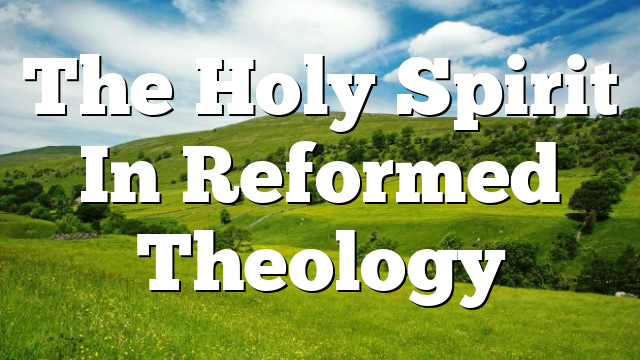Click to join the conversation with over 500,000 Pentecostal believers and scholars
Click to get our FREE MOBILE APP and stay connected
| PentecostalTheology.com



616
Book Reviews
Cornelis van der Kooi,This Incredibly Benevolent Force: The Holy Spirit in Reformed
Theology and Spirituality(Grand Rapids,MI: William B. Eerdmans Publishing
Company, 2018). 176 pp. $38.00 hardcover.
When I was a student at a reformed seminary, a professor candidly remarked in a systematic theology course that the reformed tradition was guilty of hav- ing neglected pneumatology. Even though van der Kooi mentions the recent resurgence in the study of pneumatology, he does not mention many reformed theologians. It is for that reason that this latest work by Cornelis van der Kooi is a welcome addition, especially as it creates another bridge for conversations with Pentecostals.
This work stems from van der Kooi’s 2014 Annie Kinkead Warfield Lectures delivered at Princeton Theological Seminary. Because it is a pneumatology of reformedtheology, it is highly Christological. Specifically, van der Kooi’s explo- ration of pneumatology is through Spirit Christology, and one could point to this approach as the strength of van der Kooi’s pneumatology, since it attests to the biblical portrayal of Spirit as the testifier of Jesus. However, some could also view this as a weakness because of the lack of principle spotlight given to the Spirit despite the emphasis hinted in the title. This book is not on pneuma- tology as such, but on Spirit Christology and Trinitarian theology. Yet, for those who were anticipating a unique contribution to pneumatology, perhaps this method is a contribution that reformed theology can make toward pneumatol- ogy; that is, a pneumatology that cannot be understood apart from Christology and, ultimately, Trinitarian theology. As such, this work provides pneumatolog- ical perspectives on its subjects, but is not a standalone pneumatology.
Although van der Kooi does not explicitly mention this method, the top- ics of the chapters confirm it. The first chapter acts as an introduction to the renewed interest in pneumatology. Three out of the next four chapters are devoted to Spirit Christology: chapter two makes the case for Spirit Christol- ogy against Logos Christology; chapter three reinterprets Logos Christology in order to make Logos and Spirit Christology complementary models; and chapter five reimagines the traditional threefold offices of Christ pneumatolog- ically. Chapter four almost acts as an excursus, as it devotes its pages to Calvin, Schleiermacher, and Kuyper’s pneumatology. Chapter six explores the topic of discernment, but it too ties the Spirit to Christ, in order to limit the dangers of “human” inventions. In typical reformed fashion, Christ acts as the bound- ary marker for the freedom of the Spirit, and one can hear the echoes of those who bemoaned this Christological impasse in the theology of religions. Once again, this is why van der Kooi’s method can be seen as a strength to some and a weakness to others.
PNEUMA
© koninklijke brill nv, leiden, 2018 | doi:10.1163/15700747-04004023
1
Book Reviews
617
That this book was a compilation of lectures is evident. While the chap- ters provide quality materials, the chapters themselves do not provide logical flow. This, of course, is not atypical of academic books that are arrangements of lectures or journal articles. In fact, in that genre, this book provides better coherence than most, and this coherence is provided by Christology. For the reformed tradition, Spirit Christology perhaps provides fresh perspectives to Christology. Indeed, this is where the book shines. For example, van der Kooi calls for a move away from Logos Christology. For him, Logos Christology por- trays a docetic Jesus, one whose humanity is undermined. An examination of Jesus’ life reveals its contingency, with all of its frailty and finitude. Spirit Christology, however, takes the role of the Spirit’s anointing in Jesus’ ministry seriously into account, and thus highlights the humanity of Jesus. The human- ity of Jesus is central to the revelation of the kenotic God, and the Spirit is who bridges Jesus to the Godhead and to us. Moreover, the Spirit’s anointing invites the question of the church’s own anointing and mission, continuing Jesus’ min- istry on earth.
Pentecostals who are interested in Spirit Christology will benefit from this book. In addition, reformed charismatics and those who are interested in reformed-Pentecostal dialogue may find this book to be of interest. This is because van der Kooi highlights the renewal movement as one of the promi- nent reasons for the renewed interest in pneumatology, which is found in chapter one. In it, van der Kooi lists five factors for the surging interest in pneu- matology: a growing interest in religion and spirituality through experience of a divine Spirit; a renewed interest in Trinitarian theology and the Spirit’s active role in the present; modern biblical research on the Spirit’s presence in the Old and New testaments; the rise of renewal movements; and the rise of ecu- menism. Van der Kooi has much to remark on the renewal movement, and he bemoans the fact that reformed theology had relegated much of the Spirit’s work to conversion and holiness. Because it had drunk deeply from the well of modernity, it has kept the work of God within the confines of the spiritual, leav- ing much of ordinary life untouched by the supernatural. Pentecostalism, how- ever, has a keen sense of God’s involvement in ordinary life.Taking seriously the experience of the Spirit within practice, therefore, van der Kooi calls for the need of theology of practice and experience, which would guide the four-fold functions of dogmatics: description, normativity, exploration, and orientation. One can thus see how pneumatology reshapes the methods of reformed the- ology. This method is also Pentecostalism’s forte, and this avenue for dialogue becomes clear.
The book itself is accessible, mostly free of technical jargon, and will be a good resource for undergraduate theology students. While I acknowledged ear-
PNEUMA 40 (2018) 563–624
2
618
Book Reviews
lier of its lack of coherent flow, this lack does not hinder the quality of the materials. Especially for those interested in the topics of Spirit Christology, reformed theology, and theology of religions, this book will be a valuable, intro- ductory resource.
Yoon Shin
Southeastern University, Lakeland, Florida yhshin@seu.edu
PNEUMA 40 (2018) 563–624
3


